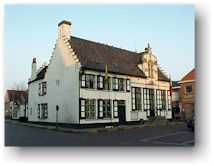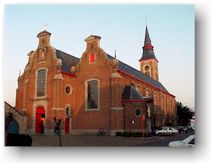|
Picture: market square of Bruges |
| start > gb > arounddamme > oedelem |
|
» Aardenburg » Abbey of Ter Doest » Adegem » Bruges » Castle of Middelburg » Donk » Dudzele » Fort of Bavaria » Knokke-Heist » Koolkerke » Lissewege » Maldegem » Male » Middelburg » Oedelem » Sint-Anna-Ter-Muiden » Sluis |
Oedelem
The birth of the presently known Oedelem was, from the 10th century on, greatly due to the lords of "van Praet", a family that also played an important role in Moerkerke. They built a stronghold in the neighourhood of "het Vliegende Paard" (the flying horse); the village of Oedelem fell under their authority. They also founded the parish Oedelem and ordered for a house of magistrates to be built on the market square (on the place of the present municipal hall). This municipal hall was raised in 1752. Next to Praet, there were some other manors in the Oedelem area, such as "Ten Torre". This domain depended directly on the burg (castle, citadel) of Bruges. There already used to be a castle on this place in the 14th century, but the one that can be seen nowadays dates back to the 19th century.
At the end of the 14th century, a battle took place between Bruges and Ghent on the "Beverhoutsveld". The reason for this conflict lies in the fact that the people from Bruges were digging a canal to the Leie. Thinking that the water level would drop too much in the Leie for the trade, those from Ghent intervened military and surprised the diggers. The canal was nevertheless dug, be it then only in 1620.
The main industry has always been agriculture (and horticulture). Untill a few decades ago, there were also several potteries for bricks and tiles. This industy already commenced in the early Middle Ages and supplied material for lots of buildings in the region such as the Bruges' Halls. Worth seeing: market square, municipal hall, church.
|
|
|
© Hendrik De Leyn - www.damme-online.com |

 South
of
South
of  The
first stone church is said to be built around 1100. After a
destruction by the Geuzen (protestant religious warriors), she
was reconstructed in 1629 and, because of the growing population,
enlarged in the 18th and 19th century. During World War II, the
church was severely hit by German artillery fire.
The
first stone church is said to be built around 1100. After a
destruction by the Geuzen (protestant religious warriors), she
was reconstructed in 1629 and, because of the growing population,
enlarged in the 18th and 19th century. During World War II, the
church was severely hit by German artillery fire.